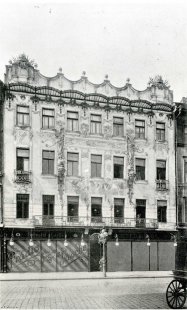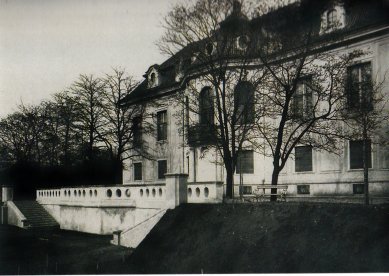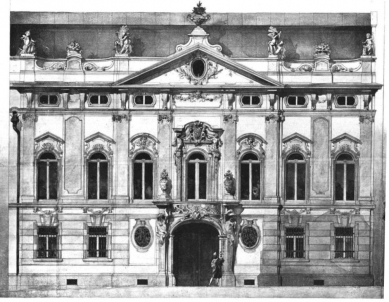
Friedrich Ohmann: The Discovery of Baroque and the Beginnings of Modern Architecture in Bohemia
Opening: November 7, 2013 at 6 PM
Exhibition lasts: November 8, 2013 – January 4, 2014
Curator: Jindřich Vybíral
Friedrich Ohmann (1858-1927) was the first professor of architecture at the Art and Design School in Prague and a significant creator of neo-baroque and Art Nouveau architecture in both Czechia and Austria. The exhibition presents Ohmann's work in the Czech lands and shows the connection between his study of baroque monuments and his efforts to create a modern architectural style.
Friedrich Ohmann was one of the most significant Central European architects around the year 1900, and his numerous works are scattered along the axis between Split and Magdeburg. From 1899 to 1907, he led the completion of the imperial residence in Vienna, and from 1904, he was a professor of architecture at the Vienna Academy of Fine Arts. Despite holding significant social positions, he enjoyed a reputation as a modern artist. He was also one of the four architects who were founding members of the Vienna Secession.
In 1888, Ohmann became the first professor of architecture at the Art and Design School in Prague, where he worked until 1898. He trained several prominent architects, such as Bedřich Bendelmayer, Alois Dryák, and Jiří Justich, and carried out numerous projects in Czechia. Among his most important Prague works are the Valter Palace, the interiors of the theater in Karlín, Hotel Central, and later the villa of Karel Kramář. The Café Corso designed by Ohmann is considered the first Art Nouveau building in the Czech capital. The critic Karel B. Mádl referred to Ohmann as the John the Baptist of Prague modernism.
The concept of modernity represented by Ohmann's work was not based on a revolutionary turn towards utilitarian values, that is, the subordination of form to function. His modernity was evolutionary—created through a dialectical synthesis of the best ideas of the past with contemporary building types and constructions. Its starting point was the study of baroque architecture. Baroque, as the embodiment of "openness" of form, was a significant stimulus for Ohmann to develop personal creativity—providing him with a middle path between the absolute freedom of artistic imagination and the rationality of rules and laws, as demanded by the historicism of the 19th century. Additionally, from the works of baroque architects, particularly K. I. Dientzenhofer, Ohmann learned to design with regard to broader spatial relationships and the genius loci. Thus, baroque served him as a means of expressing local and regional identity.
The exhibition at the AAAD presents Ohmann as a protagonist of contextual architecture, engaging in a dialogue with the environment during design and striving for a wise concord between the old and the new. It shows the connection between his study of baroque architecture and his effort to create a modern architectural language that absorbs the strength of local building tradition. Ohmann's activities in the Czech lands are presented through drawings, graphic prints, and historical and contemporary photographs. The exhibition will run at the Gallery UM of the AAAD from November 8, 2013, to January 4, 2014.
Exhibition lasts: November 8, 2013 – January 4, 2014
Curator: Jindřich Vybíral
Friedrich Ohmann (1858-1927) was the first professor of architecture at the Art and Design School in Prague and a significant creator of neo-baroque and Art Nouveau architecture in both Czechia and Austria. The exhibition presents Ohmann's work in the Czech lands and shows the connection between his study of baroque monuments and his efforts to create a modern architectural style.
Friedrich Ohmann was one of the most significant Central European architects around the year 1900, and his numerous works are scattered along the axis between Split and Magdeburg. From 1899 to 1907, he led the completion of the imperial residence in Vienna, and from 1904, he was a professor of architecture at the Vienna Academy of Fine Arts. Despite holding significant social positions, he enjoyed a reputation as a modern artist. He was also one of the four architects who were founding members of the Vienna Secession.
In 1888, Ohmann became the first professor of architecture at the Art and Design School in Prague, where he worked until 1898. He trained several prominent architects, such as Bedřich Bendelmayer, Alois Dryák, and Jiří Justich, and carried out numerous projects in Czechia. Among his most important Prague works are the Valter Palace, the interiors of the theater in Karlín, Hotel Central, and later the villa of Karel Kramář. The Café Corso designed by Ohmann is considered the first Art Nouveau building in the Czech capital. The critic Karel B. Mádl referred to Ohmann as the John the Baptist of Prague modernism.
The concept of modernity represented by Ohmann's work was not based on a revolutionary turn towards utilitarian values, that is, the subordination of form to function. His modernity was evolutionary—created through a dialectical synthesis of the best ideas of the past with contemporary building types and constructions. Its starting point was the study of baroque architecture. Baroque, as the embodiment of "openness" of form, was a significant stimulus for Ohmann to develop personal creativity—providing him with a middle path between the absolute freedom of artistic imagination and the rationality of rules and laws, as demanded by the historicism of the 19th century. Additionally, from the works of baroque architects, particularly K. I. Dientzenhofer, Ohmann learned to design with regard to broader spatial relationships and the genius loci. Thus, baroque served him as a means of expressing local and regional identity.
The exhibition at the AAAD presents Ohmann as a protagonist of contextual architecture, engaging in a dialogue with the environment during design and striving for a wise concord between the old and the new. It shows the connection between his study of baroque architecture and his effort to create a modern architectural language that absorbs the strength of local building tradition. Ohmann's activities in the Czech lands are presented through drawings, graphic prints, and historical and contemporary photographs. The exhibition will run at the Gallery UM of the AAAD from November 8, 2013, to January 4, 2014.
The English translation is powered by AI tool. Switch to Czech to view the original text source.



0 comments
add comment











